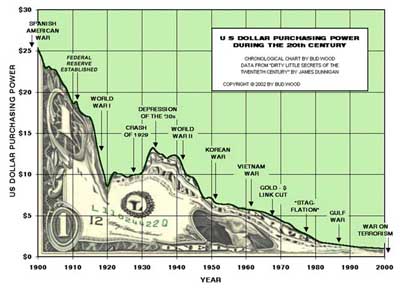|
What's A Dollar - Exactly?A US dollar is evidence of a debt that is allowed to pose as "money" by United States legal tender laws. It is far more (and far less) than just the paper bill you carry in your wallet. Dollars are created electronically whenever a bank makes a loan. You keep hearing that the dollar is "backed by the full faith and credit of the United States government." That, if it is true at all, is true only in an allegorical sense. It is backed by the US government's power to tax you and I so that it can make payments of principal and interest on the money it borrows from the Fed. In other words, the federal government does not live off our tax dollars, it lives on money it borrows from the Fed, and it taxes us so it can pay the Fed back - with interest. Primarily therefore, at least as far as the dollar's domestic value is concerned, it is backed by every borrower's promise to repay - whether that borrower is an individual, a business, or the United States government. The vast majority of US dollars are created via a bookkeeping entry by the Federal Reserve Bank when Congress borrows money from the Fed. A Fed employee creates a "credit" on the US Treasury's account. The Treasury then issues bonds and notes that are essentially promises to repay the money borrowed from the Fed. When individuals go to a private bank to apply for a loan, essentially the same thing happens. Instead of issuing bonds, etc. the borrower signs a legal document entitled a "note" of promissory note, which is a contractual promise to repay the loan over time, at interest. In return for his promise, the borrower gets a "credit" on his account. That credit is nothing ore than a bookkeeping entry. The banks gives up nothing it actually owns when it makes a loan. That promise to repay is then carried on the bank's books as an "asset". It is quite literally what backs the loan amount. That loan amount is then counted as part of the "money supply." "M1", the most liquid form of money, consists mainly of physical cash and "demand deposits." Demand deposits are bank checking and saving deposits. Every dollar you have ever earned, saved, spent, or gambled away in a casino (or the stock market) was created in the same way.
|





